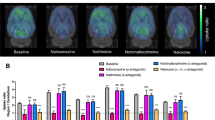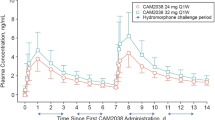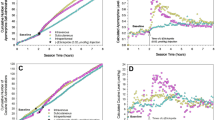Abstract
The simultaneous intravenous (i.v.) administration of heroin and cocaine, called a “speedball,” is often reported clinically, and identification of effective pharmacotherapies is a continuing challenge. We hypothesized that treatment with combinations of a dopamine reuptake inhibitor, indatraline, and a mu partial agonist, buprenorphine, might reduce speedball self-administration by rhesus monkeys more effectively than either drug alone. Speedballs (0.01 mg/kg/inj cocaine + 0.0032 mg/kg/inj heroin) and food (1 g banana pellets) were available in four daily sessions on a second-order schedule of reinforcement [fixed ratio (FR)4; variable ratio (VR)16:S]. Monkeys were treated for 10 days with saline or ascending dose combinations of indatraline (0.001-0.032 mg/kg/day) and buprenorphine (0.00032–0.01 mg/kg/day). Two combinations of indatraline (0.32 and 0.56 mg/kg/day) + buprenorphine (0.10 and 0.18 mg/kg/day) significantly reduced speedball self-administration in comparison to the saline treatment baseline (p < .01– .001), whereas the same doses of each compound alone had no significant effect on speedball-maintained responding. Daily treatment with 0.56 mg/kg/day indatraline + 0.18 mg/kg/day buprenorphine produced a significant downward shift in the speedball dose-effect curve (p < .01) and transient changes in food-maintained responding. These findings suggest that medication mixtures designed to target both the stimulant and opioid component of the speedball combination may be an effective approach to polydrug abuse treatment.
Similar content being viewed by others
Log in or create a free account to read this content
Gain free access to this article, as well as selected content from this journal and more on nature.com
or
References
Bogeso KP, Christensen AV, Hyttel J, Liljefors T . (1985): 3 Phenyl-1-indanamines: Potential antidepressant activity and potent inhibition of dopamine, norepinephrine and serotonin uptake. J Med Chem 28: 1817–1828
Condelli WS, Fairbank JA, Dennis ML, Rachal JV . (1991): Cocaine use by clients in methadone programs: Significance, scope, and behavioral interventions. J Subst Abuse Treat 8: 203–212
Corrigall WA, Coen KM . (1991): Cocaine self-administration is increased by both D1 and D2 dopamine antagonists. Pharmacol Biochem Behav 39: 799–802
Dworkin SI, Lambert P, Sizemore GM, Carroll FI, Kuhar MJ . (1998): RTI-113 administration reduces cocaine self-administration at high occupancy of dopamine transporter. Synapse 30: 49–55
Foltin RW, Christiansen I, Levin FR, Fischman MW . (1995): Effects of single and multiple intravenous cocaine injections in humans maintained on methadone. J Pharmacol Exp Ther 275: 38–47
Foltin RW, Fischman MW . (1992): The cardiovascular and subjective effects of intravenous cocaine and morphine combinations in humans. J Pharmacol Exp Ther 261: 623–632
Gastfriend DR, Mendelson JH, Mello NK, Teoh SK, Reif S . (1993): Buprenorphine pharmacotherapy for concurrent heroin and cocaine dependence. Am J Addict 2: 269–278
Glowa JR, Wojinicki FHE, Matecka D, Rice KC, Rothman RB . (1996): Sustained decrease in cocaine-maintained responding in rhesus monkeys with 1-[2-[bis (4-fluorophenyl)methoxy]ethyl]-4-(3-hydroxy-3-hydroxy-3-phenylpropyl) piperaxinyl decanoate, a long-acting ester derivative of GBR 12909. J Med Chem 39: 4628–4691
Glowa JR, Wojnicki FHE, Matecka D, Bacher JD, Mansbach RS, Balster RL, Rice KC . (1995a): Effects of dopamine reuptake inhibitors on food- and cocaine-maintained responding. I. Dependence on unit dose of cocaine. Exp Clin Psychopharmacol 3: 219–231
Glowa JR, Wojnicki FHE, Matecka D, Rice KC, Rothman RB . (1995b): Effects of dopamine reuptake inhibitors on food- and cocaine-maintained responding. II. Comparisons with other drugs and repeated administrations. Exp Clin Psychopharmacol 3: 232–239
Hemby SE, Co C, Dworkin SI, Smith JE . (1999): Synergistic elevations in nucleus accumbens extracellular dopamine concentrations during self-administration of cocaine/heroin combinations (Speedball) in rats. J Pharmacol Exp Ther 288: 274–280
Hemby SE, Martin TJ, Co C, Dworkin SI, Smith JE . (1995): The effects of intravenous heroin administration on extracellular nucleus accumbens dopamine concentrations as determined by in vivo microdialysis. J Pharmacol Exp Ther 273: 591–598
Hemby SE, Smith JE, Dworkin SI . (1996): The effects of eticlopride and naltrexone on responding maintained by food, cocaine, heroin and cocaine/heroin combinations in rats. J Pharmacol Exp Ther 277: 1247–1258
Hyttel J, Larsen JJ . (1985): Neurochemical profile of Lu 19-005, a potent inhibitor of uptake of dopamine, noradrenaline and serotonin. J Neurochem 44: 1615–1622
ILAR-NRC. (1996): Guide for the Care and Use of Laboratory Animals. Washington, DC, National Academy Press
Johnson RE, Jaffe JH, Fudala PJ . (1992): A controlled trial of buprenorphine treatment for opioid dependence. J Am Med Assoc 267: 2750–2755
Kleven MS, Koek W . (1998): Discriminative stimulus properties of cocaine: Enhancement by monoamine reuptake blockers. J Pharmacol Exp Ther 284: 1015–1025
Kleven MS, Woolverton WL . (1990): Effects of continuous infusions of SCH 23390 on cocaine- or food-maintained behavior in rhesus monkeys. Behav Pharmacol 1: 365–373
Koob GF, Bloom FE . (1988): Cellular and molecular mechanisms of drug dependence. Science 242: 715–723
Kosten TR, Kleber HD, Morgan C . (1989a): Role of opioid antagonists in treating intravenous cocaine abuse. Life Sci 44: 887–892
Kosten TR, Kleber HD, Morgan C . (1989b): Treatment of cocaine abuse with buprenorphine. Biol Psychiatry 26: 170–172
Kuhar MJ, Ritz MC, Boja JW . (1991): The dopamine hypothesis of the reinforcing properties of cocaine. Trends Neurosci 14: 299–302
Line SW . (1987): Environmental enrichment for laboratory primates. JAMA 90: 854–859
Mello NK, Bree MP, Mendelson JH . (1983): Comparison of buprenorphine and methadone effects on opiate self-administration in primates. J Pharmacol Exp Ther 225: 378–386
Mello NK, Kamien JB, Lukas SE, Mendelson JH, Drieze JM, Sholar JW . (1993a): Effects of intermittent buprenorphine administration on cocaine self-administration by rhesus monkeys. J Pharmacol Exp Ther 264: 530–541
Mello NK, Lukas SE, Kamien JB, Mendelson JH, Drieze J, Cone EJ . (1992): The effects of chronic buprenorphine treatment on cocaine and food self-administration by rhesus monkeys. J Pharmacol Exp Ther 260: 1185–1193
Mello NK, Lukas SE, Mendelson JH, Drieze J . (1993b): Naltrexone-buprenorphine interactions: Effects on cocaine self-administration. Neuropsychopharmacology 9: 211–224
Mello NK, Mendelson JH . (1980): Buprenorphine suppresses heroin use by heroin addicts. Science 27: 657–659
Mello NK, Mendelson JH . (1995): Buprenorphine treatment of cocaine and heroin abuse. In Cowan A, Lewis JW (eds), Buprenorphine: Combating Drug Abuse with a Unique Opioid. New York, John Wiley & Sons, Inc., pp 243–287
Mello NK, Mendelson JH, Bree MP, Lukas SE . (1989): Buprenorphine suppresses cocaine self-administration by rhesus monkey. Science 245: 859–862
Mello NK, Mendelson JH, Bree MP, Lukas SE . (1990): Buprenorphine and naltrexone effects on cocaine self-administration by rhesus monkeys. J Pharmacol Exp Ther 254: 926–939
Mello NK, Negus SS . (1996): Preclinical evaluation of pharmacotherapies for treatment of cocaine and opiate abuse using drug self-administration procedures. Neuropsychopharmacology 14: 375–424
Mello NK, Negus SS . (1998): The effects of buprenorphine on self-administration of cocaine and heroin “speedball” combinations and heroin alone by rhesus monkeys. J Pharmacol Exp Ther 285: 444–456
Mello NK, Negus SS . (1999): Effects of flupenthixol and quadazocine on self-administration of speedball combinations of cocaine and heroin by rhesus monkeys. Neuropsychopharmacology 21: 575–588
Mello NK, Negus SS, Lukas SE, Mendelson JH, Sholar JW, Drieze J . (1995): A primate model of polydrug abuse: Cocaine and heroin combinations. J Pharmacol Exp Ther 274: 1325–1337
Mendelson JH, Mello NK . (1996): Management of cocaine abuse and dependence. N Engl J Med 334: 965–972
National Research Council Committee on Clinical Evaluation of Narcotic Antagonists. (1978): Clinical evaluation of naltrexone treatment of opioid-dependent individual. Arch Gen Psychiatry 35: 335–340
Negus SS, Brandt MR, Mello NK . (1999): Effects of the long-acting monoamine reuptake inhibitor indatraline on cocaine self-administration in rhesus monkeys. J Pharmacol Exp Ther 291: 60–69
Negus SS, Dykstra LA . (1989): Neural substrates mediating the reinforcing properties of opioid analgesics. In Watson RW (ed), Biochemistry and Physiology of Substance Abuse, Vol. 1. Boca Raton, FL, CRC Press, pp 211–242
Negus SS, Gatch MB, Mello NK . (1998a): Discriminative stimulus effects of a cocaine/heroin “speedball” combination in rhesus monkeys. J Pharmacol Exp Ther 285: 1123–1136
Negus SS, Mello NK, Lamas X, Mendelson JH . (1996): Acute and chronic effects of flupenthixol on the discriminative stimulus and reinforcing effects of cocaine in rhesus monkeys. J Pharmacol Exp Ther 278: 879–890
Negus SS, Mello NK, Lukas SE, Mendelson JH . (1995): Diurnal patterns of cocaine and heroin self-administration in rhesus monkeys responding under a schedule of multiple daily sessions. Behav Pharmacol 6: 763–775
NIDA. (1999): Epidemiologic Trends in Drug Abuse, NIH Publication No. 00–4529. National Institute on Drug Abuse, pp 187
O'Brien CP . (1996): Drug addiction and drug abuse. In Goodman and Gilman (eds), The Pharmacological Basis of Therapeutics. New York, McGraw Hill Co., pp 557–577
Platt DM, Grech DM, Rowlett JK, Spealman RD . (1999): Discriminative stimulus effects of morphine in squirrel monkeys: Stimulants, opioids, and stimulant-opioid combinations. J Pharmacol Exp Ther 290: 1092–1100
Preston KL, Sullivan JT, Strain EC, Bigelow GE . (1996): Enhancement of cocaine's abuse liability in methadone maintenance patients. Psychopharmacology 123: 15–25
Richardson NR, Smith AM, Roberts DCS . (1994): A single injection of either flupenthixol decanoate or haloperidol decanoate produces long-term changes in cocaine self-administration in rats. Drug Alcohol Dep 36: 23–25
Ritz MC, Lamb RJ, Goldberg SR, Kuhar MJ . (1987): Cocaine receptors on dopamine transporters are related to self-administration of cocaine. Science 237: 1219–1223
Rothman RB, Glowa JR . (1995): A review of the effects of dopaminergic agents on humans, animals, and drug-seeking behavior, and its implications for medication development: Focus on GBR 12909. Molecular Neurobiology 10: 1–19
Rowlett JK, Spealman RD . (1998): Opioid enhancement of the discriminative stimulus effects of cocaine: Evidence for involvement of μ and δ opioid receptors. Psychopharmacology 140: 217–224
Rowlett JK, Wilcox KM, Woolverton WL . (1998): Self-administration of cocaine-heroin combinations by rhesus monkeys: Antagonism by naltrexone. J Pharm Exp Ther 286: 61–69
Rowlett JK, Woolverton WL . (1997): Self-administration of cocaine and heroin combinations by rhesus monkeys responding under a progressive-ratio schedule. Psychopharmacology (Berl) 133: 363–371
Schecter A . (1980): The role of narcotic antagonists in the rehabilitation of opiate addicts: A review of naltrexone. Am J Drug Alcohol Abuse 7: 1–18
Schottenfeld RS, Pakes J, Ziedonis D, Kosten TR . (1993): Buprenorphine: Dose-related effects on cocaine and opioid use in cocaine-abusing opioid-dependent humans. Biol Psychiatry 3: 66–74
Schottenfeld RS, Pakes JR, Oliveto A, Ziedonis D, Kosten TR . (1997): Buprenorphine vs. methadone maintenance treatment for concurrent opioid dependence and cocaine abuse. Arch Gen Psychiatry 54: 713–720
Schütz CG, Vlahov D, Anthony JC, Graham NMH . (1994): Comparison of self-reported injection frequencies for past 30 days and 6 months among intravenous drug users. J Clin Epidemiol 47: 191–195
Spealman RD, Bergman J . (1992): Modulation of the discriminative stimulus effects of cocaine by mu and kappa opioids. J Pharmacol Exp Ther 261: 607–615
Spealman RD, Bergman J . (1994): Opioid modulation of the discriminative stimulus effects of cocaine: Comparison of μ, κ and δ; agonists in squirrel monkeys discriminating low doses of cocaine. Behav Pharmacol 5: 21–31
Walsh SL, Sullivan JT, Preston KL, Garner J . (1996): The effects of naltrexone on response to i.v. cocaine, hydromorphone and their combination in humans. J Pharmacol Exp Ther 279: 524–538
Winger G . (1994): Dopamine antagonist effects on behavior maintained by cocaine and alfentanil in rhesus monkeys. Behav Pharmacol 5: 141–152
Woolverton WL, Johnson KM . (1992): Neurobiology of cocaine abuse. Trends Pharmacol Sci 13: 193–200
Acknowledgements
We thank Nicolas Diaz-Migoyo, Ashton Koo, and Rebecca Callahan for their technical assistance. We are grateful to Beth Moseley, D.V.M., for veterinary assistance and to Bruce Stephen for his contributions to the data analysis. Preliminary data were reported at the 1999 annual meeting of the College on Problems of Drug Dependence. This research was supported in part by KO5 DA-00101, P50 DA-04059, and RO1 DA-02519 from the National Institute on Drug Abuse, NIH.
Author information
Authors and Affiliations
Rights and permissions
About this article
Cite this article
Mello, N., Negus, S. Effects of Indatraline and Buprenorphine on Self-Administration of Speedball Combinations of Cocaine and Heroin by Rhesus Monkeys. Neuropsychopharmacol 25, 104–117 (2001). https://doi.org/10.1016/S0893-133X(00)00247-5
Received:
Revised:
Accepted:
Issue date:
DOI: https://doi.org/10.1016/S0893-133X(00)00247-5
Keywords
This article is cited by
-
Effects of d-Amphetamine and Buprenorphine Combinations on Speedball (Cocaine+Heroin) Self-Administration by Rhesus Monkeys
Neuropsychopharmacology (2007)
-
Agonist-Like or Antagonist-Like Treatment for Cocaine Dependence with Methadone for Heroin Dependence: Two Double-Blind Randomized Clinical Trials
Neuropsychopharmacology (2004)
-
Second-order stimuli do not always increase overall response rates in second-order schedules of reinforcement in the rat
Psychopharmacology (2004)



